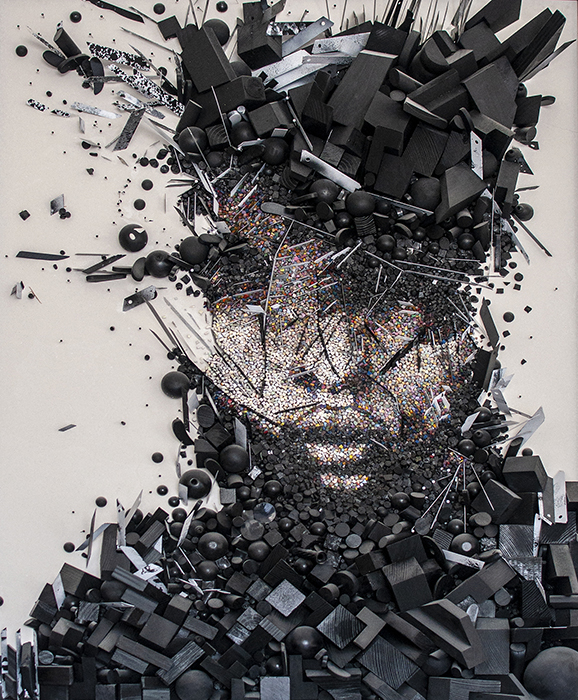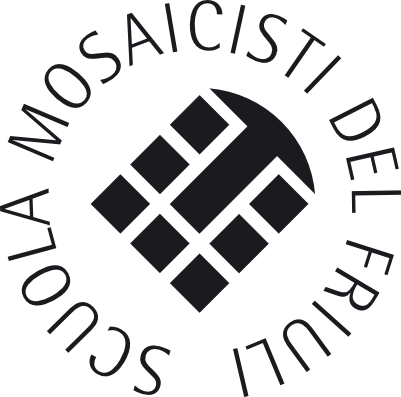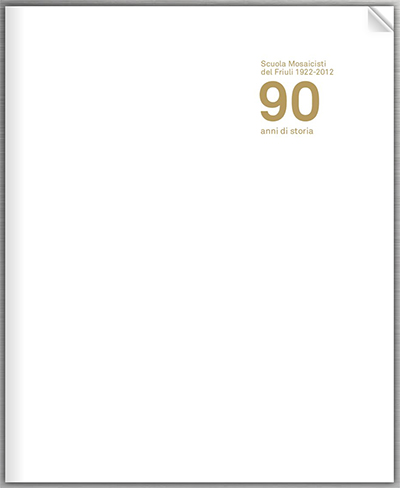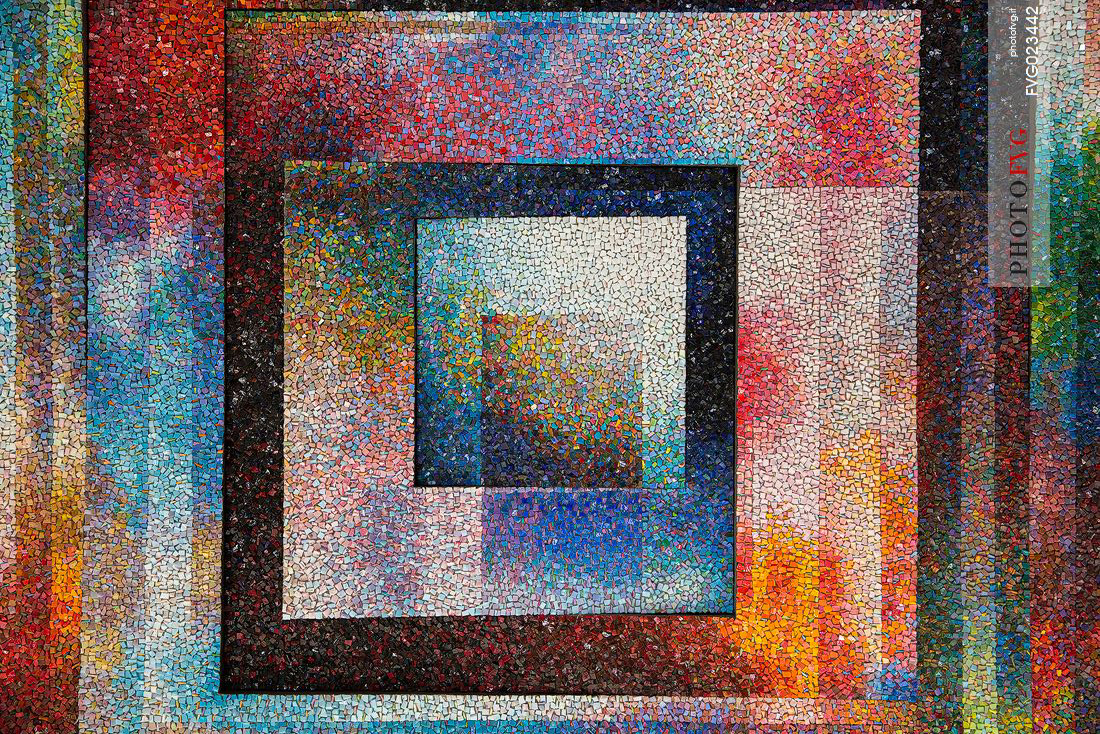Founded in 1922 the school Mosaicists aims at the didactic commitment, the association between tradition and renewal, between productive reality and cultural reality. In the brightness of the mosaic and Terrazzo laboratories, gavings, stumps and T still today mark the time of a work of distant memory. The sensitivity of the craft, untouched throughout history, in modern times feeds on new stimuli through the incomparable encounter with artists, designers and designers. The same pioneers of modern mosaic, the Sequals mosaicists of the last century, have been able to establish relationships with painters and architects by branching out their art all over the world, from the decoration of the Library of Congress in Washington to that of the Opéra In Paris. With these premises, in its didactic and productive typology, the school realizes important interventions mosaic of international recall, passing through the study and the application of the Roman, Byzantine and modern mosaic. The school today seeks above all not to forget its own reason to be and enhances the mosaic as a cultural fact as well as technical: the study, research, experimentation and use of the most innovative technologies are signs of openness and growth To and from the mosaic Art of contemporaneity.
History
It was Lodovico Zanini, delegate for Friuli of the humanitarian of Milan, to suggest the establishment of a school for Mosaicists and Ezio Cantarutti, mayor of Spilimbergo, to concretize the work. Thus in 1922 was born in Spilimbergo the mosaicists of Friuli’s school . Here and nowhere else for the deep-rooted tradition of the mosaic and the terrace present in the Mandamento.
In fact for all the ‘ 500, the ‘ 600, the ‘ 700 and the 800 from Spilimberghese there was a strong seasonal emigration to Venice, artistic crossroads par excellence between East and West, between Rome and Byzantium and therefore natural heir to the Roman and Byzantine mosaic tradition that here Admirably melt. The “Serenissima” offered the Frisian workers a job but also gave them a brilliant idea: to use the stones of their rivers. With these the craftsmen of Sequals, Colle, Solimbergo, Arba, Fanna, Cavasso Nuovo and Spilimbergo – after having collected and selected them on the Greti of the rivers Meduna and Tagliamento – departed towards Venice.
From the first half of ‘ 800 the mosaicists began to go beyond Venice: from France to the United States; from Canada to Venezuela; from Argentina to Australia; … Many of them made great fortunes. Just think of the Impresarians as the Odorico, the Ciani, the Turk, the Tramontin and especially that Gian Domenico Facchina who was born in Sequals in 1826 worked initially in Venice where he also founded a factory for the production of “Venetian enamels” (The tiles that They serve to make a mosaic). Subsequently transferred to Paris he performed works of great prestige that went to embellish town halls, churches, mosques, palaces in Bucharest, in The Hague, in Izmir, in Lourdes, in Buenos Aires, in Tokyo as well as at the Teatro Operà in Paris.
Since the beginning, the Mosaicists School of Friuli, obtained a first important recognition: the awarding of the Diploma of Honour to the first international Exhibition of Decorative Arts of Monza for a fountain performed on cardboard of the arch. Raimondo D’ Aronco. The cycle of studies was structured in three years and the programming envisaged both subjects of general cul-ture and the development of drawings, sketches and cartons as indispensable prerequisites for the conception of Mosaic compositions, whose execution was supported by Practical mosaic exercises and terrace in the laboratory.
Later the school was called to perform the entire mosaic cycle of Foro Italico in Rome. Almost 10,000 sq. m. Performed on cartoons by Angelo Canevari, Giulio Rosso, Gino Severini and Achille Capizzano. In more recent times, the mosaic works of the monastery of St. Irene near Athens (over 1,000 sq. m.), the Kawakyu Hotel in Japan (1,600 sq. m.) and the restoration work of the mosaics of the Foro Italico in Rome were important. All works carried out in collaboration with the Mosaic Laboratories managed by former students of the Spilimbergo school.
The mosaic lining of the Dome of the Holy Sepulchre in Jerusalem (MQ. 345) is instead a work entirely carried out inside the school.
Nowadays
Today the school mosaicists of Friuli is a reference point in the world for the training of professionals and the dissemination of the art of Mosaic. It is a sui generis school precisely because it imports students from all over the world (currently 22 are the nationalities present) and exports works of art in the most significant places, from New York to Beijing, from Tokyo to Sant’Antonio (Texas-USA).
The goal is to combine the preservation of tradition with innovation. The aim is to experiment and research to find new solutions, especially in the field of urban furnishing and interiors. For this close to the traditional subjects of study: Mosaic, terrace and drawing are flanked by the computer graphics, the mosaic design and the theory of color. In recent years the school has been open to the full range. It is confronted with increasing conviction, competence and success in various fields: from architecture to design; From contemporary art to restoration.
Numerous works are carried out in collaboration with architects and designers (both Italian and other nationalities), which embellish restaurants, churches, villas and various places all over the world. Just think of the great mosaic “Saetta Iridescente” for the new metro station Temporary Word Center Path Sation (Ground Zero) in new York; To the mosaic as a furnishing complement for two restaurants always in New York; To the mosaic sculpture at the entrance of the Orbessano FIAT Research Centre in Turin; To the mosaic pavement of the Piazza della Transalpina between Gorizia and Nuova Gorica; To the parietal and paving coverings for a restaurant in Tokyo; To the parietal decorations for the cultural center “Chicasaw” in Oklaohoma (USA); To the mosaic cycle for the Volksbank of Graz (Austria) and the one for the Church of San Lorenzo (L’Aquila); To the “Bible in the open air-the Old Testament” for the commune of Ceccivento (Udine). Works carried out on sketches by artists such as Zigaina, Dorazio, Ciussi, Celiberti, Licata, Cascella, Della Torre, Finzi, Gianquinto, Basaglia, Nespolo, Pittino, Pizzinate, Pozzati, Soffiantino, Lojze spacal, Strazza, Tadini, Titan, Treccani, Turchiaro, Voltolina, Nane Zavagno, De Luigi, Anzil, Mitri, just to name a few. Important interventions in the field of restoration of mosaics (those dating from the end of ‘ 800 and all ‘ 900). Think of the prestigious mosaics of the sanctuary of Lourdes in France, the mosaic work at the Venice railway station and the Dome “Maison Simons” in Quebec, Canada.

In recent years the school has participated and organized exhibition events such as “the school mosaicists of Friuli” in Angers (1997); “Aime… Comme mosaique “in Paris (1998); “Mosaic is” at Villa Manin of Passariano (2000); “The new mosaic: Selections from Friuli” in Toronto (2003); “La mosaique dans tous ses éclats” in Marseille (2005); “The school mosaicists of Friuli” in Obernaì (2005); “The school mosaicists of Friuli” in Rome (2006); “The school mosaicists of Friuli” in Veszprèm (2006); “Mosaic: Selections from Friuli” in Melbourne (2006); “Mosaic Now: Works from Italy and Australia” in Wangaratta – Geelong – Sydney (2007); “Un, deux, trois…. cailloux.
Exhibition of the <<School Mosaicists of Friuli>> Mosaique d’hier et d’aujourd’hui “in Arles (2007); “Mosaic only” in Moscow (2008); “The school mosaicists of Friuli” in Randers (2009); “The school mosaicists of Friuli” in Trieste (2009); “The school mosaicists of Friuli” in Udine (2009); “School mosaicists of Friuli” in Eeklo and Antwerp (2009); “The school mosaicists of Friuli” in Valaské Mezirici (2010); “The school mosaicists of Friuli” in Basel (2010); “The school mosaicists of Friuli” in Bratislava (2011); “Scuola Mosaicists of Friuli 1922-2012” and “artist mosaics from the experience of the school mosaicists of Friuli the works of artists” at Villa Manin of Passariano – Ud; “The school mosaicists of Friuli” in Bolzano and Verona; “The school mosaicists of Friuli” in Stuttgart (2013).






